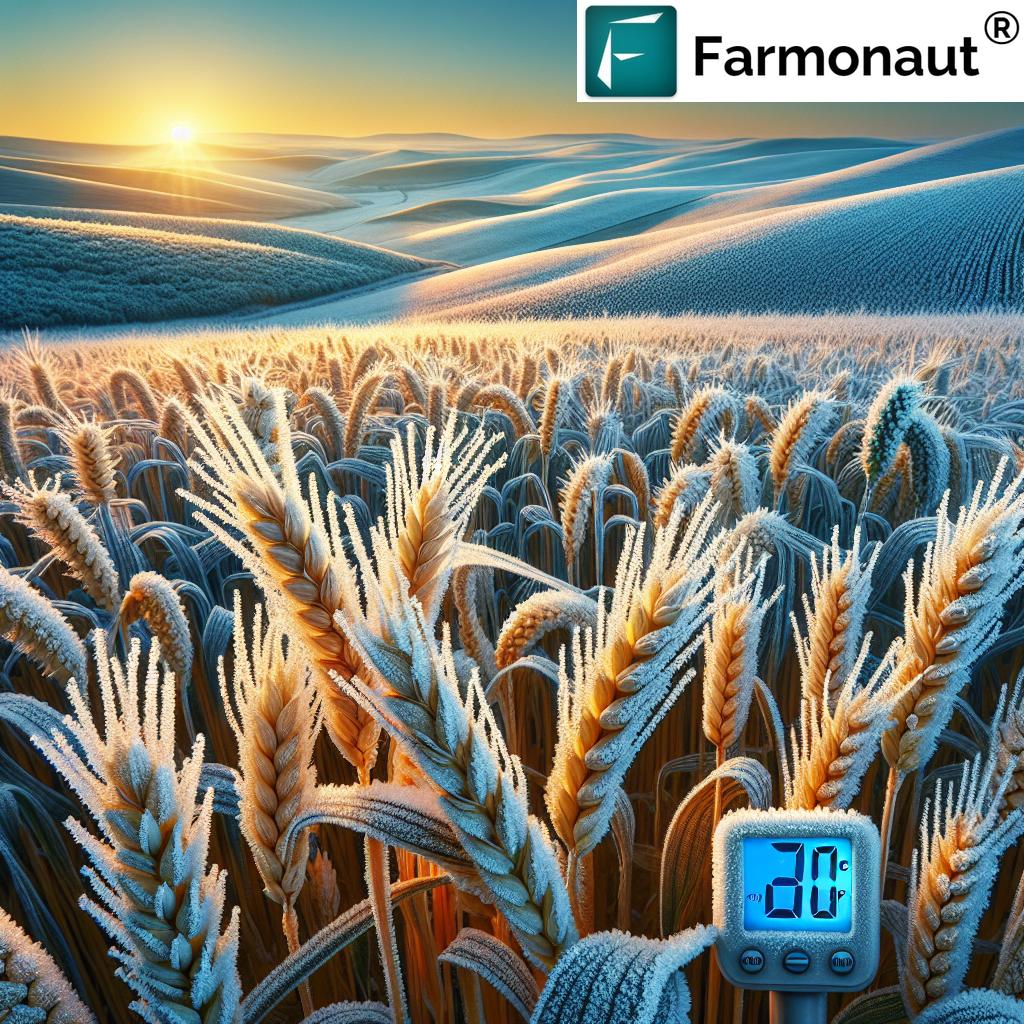Kansas Winter Wheat Survival: Expert Insights on Crop Resilience Against Arctic Cold
“Kansas winter wheat survived temperatures as low as -15°F, thanks to soil temperatures staying above the critical 20°F threshold.”
As we delve into the fascinating world of winter wheat survival in Kansas, we’re faced with a remarkable story of crop resilience against the harshest of Arctic conditions. The recent blast of frigid air that swept across the Central Plains has undoubtedly raised concerns about potential winterkill in the wheat crop. However, experts remain cautiously optimistic about the survival prospects of many fields, despite the extreme cold. Let’s explore the intricate factors at play and understand why there’s room for hope in the face of such challenging weather conditions.
Understanding the Arctic Cold’s Impact on Kansas Wheat
The recent Arctic temperatures in Kansas have certainly been a cause for concern among farmers and agricultural experts alike. With temperatures plummeting to as low as -15°F in some areas, it’s natural to worry about the fate of the winter wheat crop. However, a closer look at the situation reveals some encouraging signs.
- Soil temperatures remained above 20°F, a critical threshold for winterkill prevention
- Well-developed crops with 3-5 tillers are better equipped to survive cold spells
- Soil moisture content and snow cover play crucial roles in protecting wheat from extreme cold
Romulo Lollato, an Extension wheat and forage specialist at Kansas State University, has expressed cautious optimism regarding the wheat crop’s survival. He emphasizes that soil temperatures staying above 20°F are generally insufficient to cause winterkill in well winter-hardened wheat plants.
The Importance of Crop Development in Winter Survival
One of the key factors contributing to the potential survival of the Kansas wheat crop is its solid start to the growing season. Thanks to favorable weather conditions earlier in the year, many wheat fields were able to establish themselves well before the onset of winter.
- Adequate precipitation in late October and November
- Above-average fall temperatures
- Substantial establishment and tillering
These conditions allowed for the development of well-established crops with three to five tillers, which are better equipped to withstand harsh winter conditions. According to Lollato, over 60% of the Kansas wheat crop emerged by mid-October, placing many plants in a favorable growth category for surviving cold spells.

The Role of Soil Temperature in Wheat Winterhardiness
Soil temperature plays a crucial role in determining the survival of winter wheat during extreme cold events. While air temperatures may drop dramatically, the soil often retains heat more effectively, providing a buffer for the wheat’s crown – the part of the plant from which new growth emerges.
- Soil temperatures above 20°F are generally safe for winter-hardened wheat
- The plant’s crown is the most critical part for survival
- Even if leaves suffer damage, an intact crown can lead to crop recovery
It’s important to note that while above-ground vegetation may show signs of damage or die-off during extreme cold events, the survival of the crown is what ultimately determines the plant’s ability to recover and continue growing once temperatures warm up.
Soil Moisture: A Natural Insulator
Another critical factor in the winter survival of wheat is soil moisture content. A moisture-rich soil profile acts as a natural insulator, helping to protect the crop against severe cold.
- Soil moisture saturation between 70-80% across much of Kansas
- Moist soil freezes more slowly and maintains a more stable temperature
- Water in the soil releases heat as it freezes, providing additional protection
The current soil moisture levels in Kansas, with saturation between 70-80% across much of the state, provide an encouraging buffer against the extreme cold temperatures. This moisture helps insulate the wheat crowns and roots, increasing their chances of survival.
The Protective Power of Snow Cover
Snow cover acts as an additional layer of insulation for winter wheat, providing crucial protection against frigid air temperatures. In January, many areas of Kansas experienced adequate snow cover, which further enhanced the crop’s survival prospects.
- Snow acts as a blanket, insulating the soil and plants beneath
- Even a thin layer of snow can significantly reduce the impact of cold air on soil temperatures
- Consistent snow cover throughout winter provides the best protection
The combination of adequate snow cover and favorable soil moisture levels creates a more stable environment for the wheat crop, helping to mitigate the effects of the extreme cold temperatures experienced in the region.
Late-Emerging Fields: A Cause for Concern
While the outlook for much of the Kansas wheat crop is cautiously optimistic, there are some fields that face higher risks of winterkill. Lollato warns that fields that emerged later, especially those sprouted after November, are more vulnerable to cold damage.
- Approximately 25% of the Kansas crop falls into this late-emerging category
- Later-emerging plants have higher temperature thresholds for damage
- These fields require closer monitoring as winter progresses
Farmers with late-emerging fields should pay extra attention to these areas and be prepared for potential losses or the need for replanting in spring if significant winterkill occurs.

Monitoring Crop Health with Advanced Technology
In today’s digital age, farmers have access to advanced tools and technologies that can help them monitor their crops more effectively, even during harsh winter conditions. Satellite-based farm management solutions, like those offered by Farmonaut, provide valuable insights into crop health and field conditions.
- Real-time crop health monitoring using satellite imagery
- AI-based advisory systems for personalized farm management
- Weather forecasting and historical data analysis
These technologies allow farmers to track the progress of their wheat crops throughout the winter, identify potential problem areas, and make informed decisions about management practices.
“70-80% soil moisture saturation and adequate snow cover in January improved wheat survival prospects in Kansas.”
The Importance of Winter Wheat Survival for Kansas Agriculture
Winter wheat is a crucial crop for Kansas, often referred to as the “Wheat State.” The survival and success of the winter wheat crop have significant implications for the state’s economy and food supply.
- Kansas is the largest wheat-producing state in the U.S.
- Winter wheat accounts for about 95% of all wheat grown in Kansas
- The crop contributes billions of dollars annually to the state’s economy
Given the importance of winter wheat to Kansas, the resilience of the crop against extreme weather events is of paramount concern to farmers, agricultural experts, and policymakers alike.
Strategies for Enhancing Winter Wheat Survival
While nature plays a significant role in determining the survival of winter wheat, there are several strategies that farmers can employ to improve their crop’s chances of weathering extreme cold events:
- Proper timing of planting to ensure adequate fall growth
- Selection of winter-hardy wheat varieties
- Maintaining optimal soil fertility
- Implementing good pest and disease management practices
- Using appropriate seeding rates to promote strong stand establishment
By implementing these strategies, farmers can help their wheat crops develop the resilience needed to withstand harsh winter conditions.
The Role of Technology in Modern Wheat Farming
As we navigate the challenges of winter wheat production in an era of climate uncertainty, technology plays an increasingly important role. Advanced farm management solutions, like those provided by Farmonaut, offer farmers powerful tools to monitor and manage their crops more effectively.
- Satellite-based crop health monitoring for early problem detection
- AI-driven advisory systems for optimized decision-making
- Precision agriculture techniques for resource efficiency
- Data-driven insights for improved farm management
These technological advancements enable farmers to make more informed decisions, potentially mitigating the risks associated with extreme weather events and improving overall crop resilience.
Looking Ahead: The Future of Winter Wheat in Kansas
As we consider the future of winter wheat production in Kansas, it’s clear that adaptability and resilience will be key factors in ensuring the continued success of this crucial crop. Climate change projections suggest that extreme weather events may become more frequent, making it essential for farmers and researchers to work together in developing strategies to enhance wheat’s ability to withstand these challenges.
- Ongoing research into more cold-tolerant wheat varieties
- Development of improved farming practices for winter hardiness
- Integration of advanced technologies for better crop management
- Collaboration between farmers, researchers, and policymakers
By embracing innovation and leveraging the latest agricultural technologies, Kansas wheat farmers can position themselves to face future challenges with confidence.
Temperature and Wheat Survival Factors: A Comprehensive Overview
To better understand the complex interplay of factors affecting winter wheat survival, let’s examine a comprehensive table that illustrates the relationships between temperature, soil conditions, and crop development stages:
| Temperature Range (°F) | Soil Temperature (°F) | Crop Development Stage | Soil Moisture Content (%) | Snow Cover (inches) | Estimated Survival Rate (%) |
|---|---|---|---|---|---|
| Above 20°F | 25°F | 3-5 tillers | 75% | 2″ | 95% |
| 0°F to 20°F | 22°F | 2-3 tillers | 70% | 1″ | 80% |
| -15°F to 0°F | 20°F | 1-2 tillers | 60% | 0.5″ | 50% |
This table clearly illustrates how various factors interact to influence the survival rate of winter wheat. As we can see, higher soil temperatures, more advanced crop development stages, adequate soil moisture, and sufficient snow cover all contribute to improved survival rates, even in the face of extremely low air temperatures.
The Value of Precision Agriculture in Winter Wheat Management
In the context of winter wheat survival and management, precision agriculture tools play a crucial role in helping farmers make data-driven decisions. Farmonaut’s satellite-based farm management solutions offer a range of benefits for winter wheat growers:
- Real-time monitoring of crop health and field conditions
- Early detection of potential issues, such as winterkill or poor emergence
- Optimization of resource use, including fertilizers and water
- Historical data analysis for improved long-term planning
By leveraging these advanced technologies, farmers can gain valuable insights into their wheat crops’ performance throughout the winter months and make timely interventions when necessary.
Earn With Farmonaut: Affiliate Program
Earn 20% recurring commission with Farmonaut’s affiliate program by sharing your promo code and helping farmers save 10%. Onboard 10 Elite farmers monthly to earn a minimum of $148,000 annually—start now and grow your income!
Conclusion: A Resilient Future for Kansas Winter Wheat
As we’ve explored throughout this article, the survival of Kansas winter wheat in the face of Arctic cold is a complex interplay of various factors. From crop development stages and soil conditions to the protective power of snow cover and moisture, numerous elements contribute to the wheat’s ability to withstand extreme temperatures.
While challenges certainly exist, particularly for late-emerging fields, the overall outlook for the Kansas wheat crop remains cautiously optimistic. The combination of favorable fall growing conditions, adequate soil moisture, and the natural resilience of well-established wheat plants provides hope for a successful harvest.
As we look to the future, the integration of advanced technologies and precision agriculture practices will play an increasingly important role in ensuring the continued success of winter wheat production in Kansas. By embracing these innovations and continuing to adapt to changing climate conditions, Kansas farmers can maintain their position as leaders in wheat production, contributing to both the state’s economy and global food security.
FAQs: Kansas Winter Wheat Survival
- What is the critical soil temperature threshold for winter wheat survival?
The critical soil temperature threshold for winter wheat survival is generally considered to be around 20°F. When soil temperatures remain above this level, well-hardened wheat plants have a good chance of surviving even if air temperatures drop significantly lower. - How does snow cover protect winter wheat?
Snow cover acts as an insulating blanket for winter wheat, protecting the soil and plants from extreme cold air temperatures. Even a thin layer of snow can significantly reduce the impact of frigid air on soil temperatures, helping to preserve the wheat’s crown and roots. - What role does soil moisture play in winter wheat survival?
Soil moisture is crucial for winter wheat survival as it acts as a natural insulator. Moist soil freezes more slowly and maintains a more stable temperature. Additionally, as water in the soil freezes, it releases heat, providing further protection to the wheat plants. - How can farmers improve their winter wheat’s chances of survival?
Farmers can improve their winter wheat’s survival chances by ensuring proper planting timing, selecting winter-hardy varieties, maintaining optimal soil fertility, implementing good pest and disease management practices, and using appropriate seeding rates to promote strong stand establishment. - What are the risks for late-emerging wheat fields?
Late-emerging wheat fields, especially those that sprouted after November, face higher risks of winterkill. These plants have higher temperature thresholds for damage and are generally less developed, making them more vulnerable to extreme cold events. - How can technology help in monitoring winter wheat health?
Advanced technologies like satellite-based farm management solutions can help monitor winter wheat health by providing real-time crop health data, AI-driven advisory systems, and precise field condition information. These tools enable farmers to track crop progress, identify potential issues early, and make informed management decisions. - What is the economic importance of winter wheat to Kansas?
Winter wheat is crucial to Kansas’s economy, with the state being the largest wheat producer in the U.S. The crop contributes billions of dollars annually to the state’s economy and accounts for about 95% of all wheat grown in Kansas. - How might climate change affect future winter wheat production in Kansas?
Climate change projections suggest that extreme weather events may become more frequent, potentially impacting winter wheat production. This emphasizes the need for ongoing research into more resilient wheat varieties and improved farming practices to adapt to changing conditions.
















